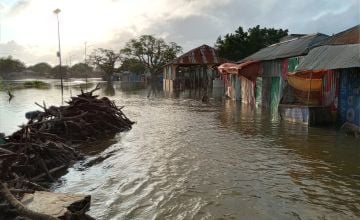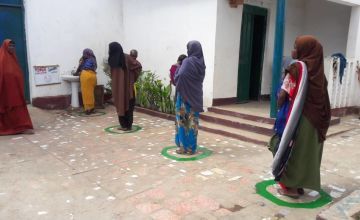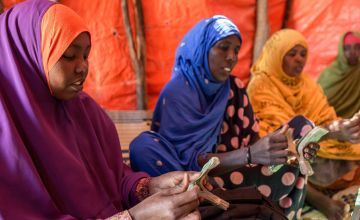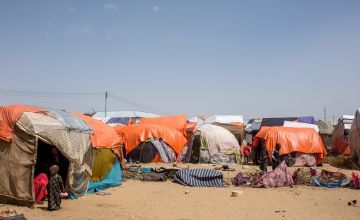
Read our 2024 annual report

Knowledge Hub
Here are seven things to know about Somalia’s cycle of crisis in 2022.
In the last two years, Somalia has been hit by multiple floods, a cyclone, swarms of locusts, and Covid-19 — all coming hot on the heels of a decades-long drought and conflict. All of this creates layers of complexity and an ongoing cycle of crisis. Here are seven things to know about Somalia’s cycle of crisis in 2022.
1. Despite decades of drought, Somalia also faces frequent flooding
In the last two years, hundreds of thousands of people have been affected by seasonal flooding in Somalia, which have damaged hundreds of thousands of acres of farmland and kept whole villages underwater. This is, by all means, a significant emergency in its own right. Unfortunately, for the people of Somalia, it is not the biggest crisis they face.

Floods are, sadly, a regular occurrence for communities living along the Jubba and Shabelle river basins. They are a devastating byproduct of the double-edged sword that are the Gu Rains, which fall from April to June. Too little rain and farmers find themselves in a drought situation. Too much, and crops are destroyed by flooding. It is a precarious line for farmers to tread.
Our team supports flood-prone communities in Somalia through a two-pronged approach. The preemptive work helps to mitigate risk by raising awareness within communities and by sandbagging vulnerable spots along the riverbank to prevent it from bursting. In turn, our response work acts swiftly to provide affected families with unconditional cash transfers and to ensure access to safe clean water, sanitation and hygiene.
2. Somalia recently experienced its worst locust crisis in a quarter of a century

Recent rains have brought an even bigger threat. They provide favourable conditions for new generations of locusts to hatch and thrive. The threat posed by the locusts is so large that the government declared a national emergency in 2020, when large swarms moved across the country devouring crops.
It was the worst locust invasion that Somalia has experienced in 25 years. As the fourth generation of the infestation hatched in the summer of 2020, it was anticipated that 3.5 million people would not have enough food to eat between now and the end of the year.
3. Covid numbers weren’t as high in Somalia as elsewhere, but there’s still a risk of secondary deaths

There is a real fear that the novel coronavirus will lead to an increase in secondary deaths in Somalia. It is vital that all available health facilities are kept open and safe for people to visit. Concern runs a number of health facilities and mobile clinics in Somalia and our teams have gone to great lengths in order to keep those in operation and continue our health support to vulnerable communities. We have trained staff, set up triage facilities, supplied PPE and increased hand-washing facilities. In order to tackle malnutrition specifically, our teams have pre-positioned extra supplies of the therapeutic food that is used to treat malnourished children to ensure continued supplies.
The pandemic has meant that staff have had to work harder than ever, extending their working hours to adapt to new social distancing regulations. Andrea Solomon, Programme Director for Concern in Somalia, explained that extra support has also been put in place for healthcare workers who have found themselves with a heavy burden to bear. “We’re providing frontline healthcare staff with psychosocial support in recognition of the fact that their jobs are very difficult at the best of times and now they have to cope with the impact of Covid-19 as well.”
4. The one financial constant is economic turmoil

Another particularly brutal aspect of the Covid-19 crisis is that as it restricts capacity to address rising levels of hunger, it is also contributing to the problem. The economic impacts of the pandemic, both global and local, are set to make their mark, according to Abdi-Rashid Haji Nur, Concern’s Country Director in Somalia.
“The pandemic will certainly worsen food insecurity. It will impact the domestic food market supply chains, income sources, and will limit employment opportunities. Remittances, which have been a lifeline for so many households in Somalia over the years will be hit badly as the economies of source countries continue to shrink.”
The loss of remittances alone will be a huge blow to the country. Estimates vary, but they are thought to account for as much as $2 billion each year, exceeding the amount of money that goes in by humanitarian aid, and supporting about 40% of the population.
5. Social distancing isn’t so simple

As the government and aid agencies grapple with health and economic challenges, the Somali people are also grappling with the new restrictive measures that have been put in place for their safety. The uptake of social distancing was not widespread due to a range of reasons, some of them relating to culture and the prevalence of hand-shaking and hugging in Somali culture.
Others run even deeper: “With a poverty rate of 69%, the majority of people cannot afford to stay at home and wait for a solution. Even more so the half a million displaced people in Mogadishu living in camps. They have no choice but to be out every day to feed their families,” explains Abdi Rashid Haji Nur. “They would rather risk going outside and catching the virus than staying at home and starving to death.”
This created the sense that Covid-19 is somehow normal and just another challenge for people to face. Concern engaged heavily in awareness-raising campaigns to gradually help in changing those behaviours. We have supported radio campaigns, and worked closely with artists, religious leaders, and influential community members to look for ways to get the message through. It’s not an easy task. Looming over these efforts is another simple and heart-breaking fact. People are much more afraid of dying from bullets and bombs than they are of Covid-19.
6. Somalia has been gripped by decades of conflict
The people of Somalia have been plagued by the violence and brutality of conflict for three decades now. It is the crisis that arches over all the others and it is conflict that has weakened the health system to the level that it is at today. Indeed, it has weakened the state to such an extent that huge portions of the country are not under government control.
This means that government and humanitarian response to crises such as droughts, locusts or Covid-19 will never reach much of the population – and it makes gaining access to other regions both difficult and dangerous, as Abdi Rashid Haji-Nur explains: “Operationally, it is difficult for national and international humanitarian agencies to deliver services to people in the different parts of the country. As long as there is absence of efforts to contain and to deescalate those tensions and conflicts, we will be having challenges in terms of having access.”
Making matters worse is the potential that other crises have to exacerbate tensions within the country. “The effects of the pandemic, or the locust infestation, or the effects of climate change like flooding or drought… You name it, one after the other, they’re all enough to intensify conflicts over resources and power within the country,” says Abdi. Put simply, it is a vicious cycle of crisis and violence within Somalia. Conflict complicates efforts to adequately respond to Covid-19, swarms of locusts, or climate crises, and in turn, each of those crises can exacerbate conflict.
7. Progress is possible
It is a situation that seems very bleak. But we must not forget that progress is possible. Our teams in Somalia have done amazing work for decades and have seen for themselves the difference that can be made. And we’ve seen what’s possible: through collective action between aid agencies, the government, diaspora, and the affected communities, Somalia avoided a famine in 2017. There’s more along those lines that we can achieve together.
Other ways to help
Corporate support
Is your company interested in working together for a common cause?
Fundraise for Concern
From mountain trekking to marathon running, cake sales to table quizzes, there are lots of ways you can support our work.
Buy a gift
With an extensive range of alternative gifts, we have something to suit everybody.
Leave a gift in your will
Leave the world a better place with a life-changing legacy.
Volunteer with Concern
The lots of ways to get involved with our work as a volunteer
School fundraising
Without the generous support from schools, we wouldn't be able to do the work that we do.




